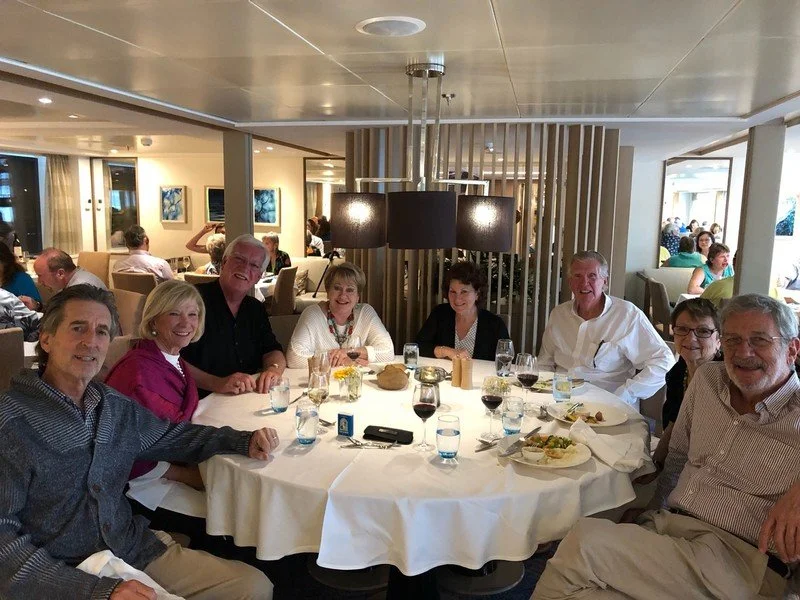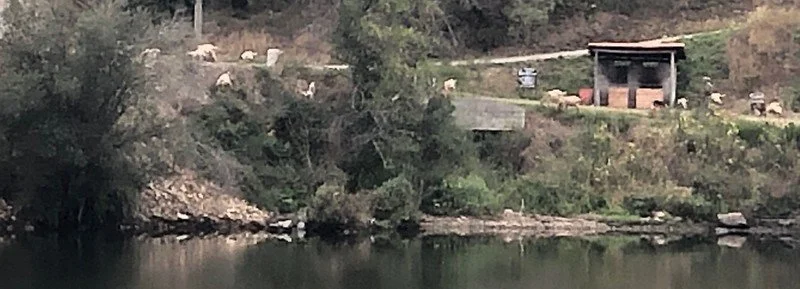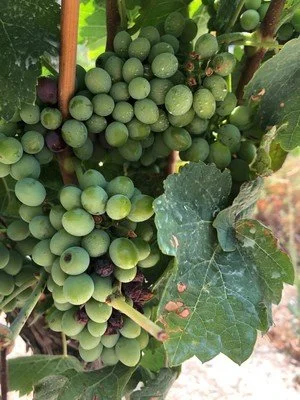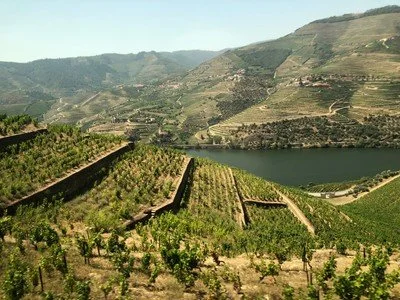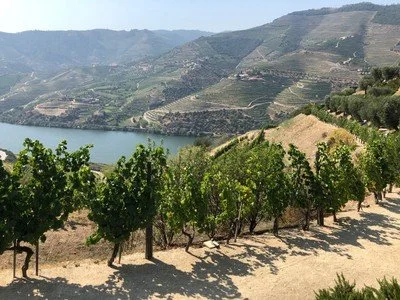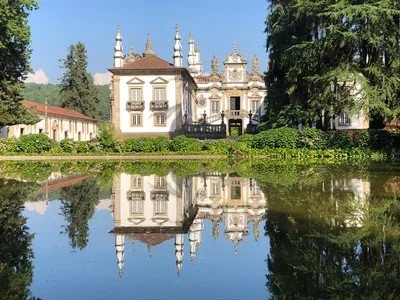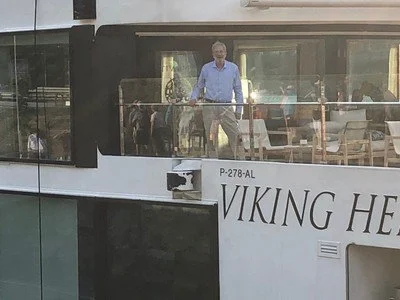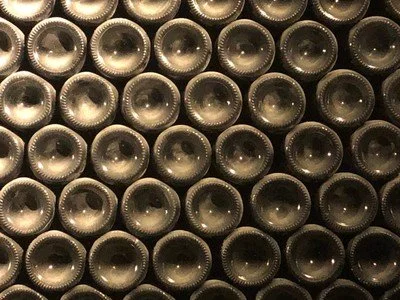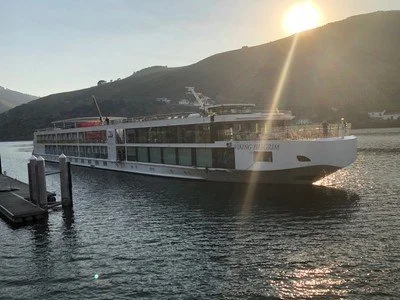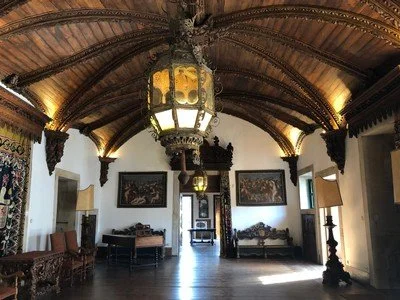7/17 Lock Her Up
Helgrim, that is
07/18/2019 - 07/18/2019 85 °F
View RussRaff to Portugal on paulej4's travel map.
Helgrim’s engine room and I come to life at about the same time; at 7:00 we push away from Porto to begin our first day on the Douro. The maneuver is so silent that B4 remains firmly moored to the pier which is our bed while I make my way for two cups of coffee to bring back to 312. I end up drinking them both.
Crestuma Lock blocks our way at 8:20, ten minutes prior to our reserved time for transit through this, the first of five locks along the Douro. I took my first ever iPhone time lapse video. Here is what Viking’s handout: “Locks Along the Douro River” says about this lock: Built: 1978-1985; Length: 316 feet; Width: 40 feet; Gate: Book shape; Lift: 46 feet.
Recall that Helgrim is 262 feet long and 39 feet wide. Therefore, at Crestuma we have 54 feet to spare in terms of length and ONE FOOT to spare in width. The Captain—and crew—of Helgrim maneuvered in an amazingly expert manner. If the ship touched either side of the lock at any point, I missed it. Once the back of the lock was sealed and the front began to admit water, by my unofficial calculation, we rose about one foot per eight seconds meaning that the time lapse of the ship rising compressed just over six minutes into around nine seconds of video.
Breakfast with Becky and Jim followed. Nancy and Allan arrived a bit later but Ward and Donna were nowhere to be seen. After enjoying the eight of us at dinner last night, they were missed.
Later, at around 10:00, I hear a shrill whistle on our port side and discover a man's dogs herding his flock. His whistles were his commands to them; they seemed to understand what he wanted them to get their underlings to do depending upon the way he whistled. Regardless, it was fun to watch but too far away to capture very well with the iPhone. I didn't bring the Nikon with the long lens on this trip knowing I wouldn't need it. Until now.
At 11:40, we are set to transit Carrapatelo Lock which is 313 feet long and, again, 40 feet wide. The primary difference between Carrapatelo in construction is that rather than have a “Book shape” gate, this lock has a “Guillotine shape.” The primary operational difference is that here we have a gigantic 115 foot rise.
Shortly thereafter, we pass beneath a low bridge and B4 gave me a comment similar to, "#%*@, Paul, get your head down." I should have shot this one in regular time rather than time lapse but you get the drift.
After sailing along the Douro, we arrive late morning in Lamego, on the opposite bank of the Douro from Régua. We head south on a twenty-minute drive to Sandeman’s Qunita do Seixo. We sample red and tawny port—I have a slight preference for the tawny here—and, after a coach ride, have a tour to Vila Real, home to Mateus Palace (the building depicted on the Mateus Rosé wine labels).
Their old label is on the left; the new label on the right. Decades ago, each Sunday evening I enjoyed a grilled steak, baked potato and bottle of Mateus, my "training wine."
Baroque, the Mateus Palace contains a "pinnacled facade, grand stairway, richly appointed interiors and priceless objects on display" which reveal formal gardens, cedar-lined walkways, precisely sculpted hedges, statuary and reflecting pools. A sculpture by João Cutileiro, has ‘slept’ in the Lake, but only since 1981.
I know little—practically nothing—of the wine variety invented in and named for Portugal: port. But I did homework ranging from watching the film “A Year in Port” on Amazon Prime to scouring the internet.
Port is a higher-alcohol sweet wine fortified with brandy (but not the commercial type one might think of), done to help it withstand the fifteenth-century voyage to England. Often enjoyed with chocolate after dinner, it is the most British of Portuguese exports.
Port wine is stored and aged here by barrel after barrel after barrel called “pipes.” Best consumed twenty years after crushing, port wine is a long-term investment for vintners. Both families of Brits, Symington Family Estates and Taylor Fladgate dominate and compete to see which is considered the most prestigious makers of port.
Their grapes are grown one hundred miles east of Porto in the Douro Valley. Feeling very much cut off from the rest of Portugal, the countryside is dark hard granite that form dark canyons where centuries-old vineyards grow on gorgeous, almost vertical slopes.
Most of the grapes here are produced by family owned growers who own tiny plots and sell their grapes to the larger wine makers. Their soil is more layered stone than dirt. There is virtually no other industry in this region so there are few jobs which creates an outflow of young people. Picking season brings the best employment nearby picking-crew villagers will get all year. They often work double shifts and at night become “treaders,” stomping the grapes just picked while wading in cadence inside large vats. This rhythm has been going on for centuries with little or no change. However, at Sandeman, robots stomp; we saw them on our tour.
In 1756, to control quality of port, regional wine exporters decreed that the government should regulate the production and sale of port wines making Douro the first regulated wine appellation in the world. In 1790, the British built Porto’s “Factory House” where weekly Wednesday members-only lunches continue to this day. Port is leisurely consumed with English Stilton Cheese to finish the meal.
Other varieties of wine emanate from this region but it is port that dominates. From a weather point of view, it is said that the Douro has “nine months of winter and three months of hell.” Producing grapes here is both difficult and risky as a mis-timed rain or cool spell can cause an entire harvest to be lost. Luck plays too great a role.
Our party would agree that the “nine months of winter and three months of hell” phrase is a weak metaphor for our journey where the Helgrim is our nine months (good) and the coach rides are our “three months of hell.” Nobody much cares for them, even as fine as they are.
Conveniently, cork trees are a native species here. You can put the cork in your wine bottle or you can make hats, belts, glasses cases, purses or whatever you like from them. We are told that cork is not combustable. In any event, we buy no cork objects.
Wines of the style produced here do come from many places (Australia, France, South Africa, Canada, India, Argentina, Spain and the United States) but under European Union rules, only that from here may be labelled as “port” or “porto.” That rule is not necessarily enforced in the U.S. where the protected nomenclature is “Oporto,” “Porto” and “Vinho do Porto.”
Ports age years in casks or barrels. The more well-known ruby ports are younger while tawny ports are older. Those are also graded: entry, reserve, old and vintage. The final art form comes when the wines are blended, older with newer, to make what the wine-maker thinks is the best product possible using eyes for color, nose for aroma and tongue for taste.
Also discovered here is something about which I previously knew nothing: white port and tonic; very British indeed. I tried one. Interesting but not as good as a vodka tonic.
We rejoin Helgrim at Folgosa. B4has opted to remain to work (Allan and Nancy remained aboard as well) while Becky, Jim, Ward and Donna and I toured. We were able to watch Helgrim dock and I thought I might get a good picture of the vessel but she was severely backlit. This is the best I could do.
Later, after a fine dinner of traditional Portuguese dishes, we made our way to the lounge and made fools of ourselves during the music trivia contest which, only because Ward and Becky seemed to be focused on honest scorekeeping, we did not win. Our 735 points was far shy of the winning team’s 830 points. (Had my arithmetic been used, we would have tallied 6,805 points).
As has become our habit, we went to bed late, tired but happily satisfied—and relieved that B4’s monthly work letter is complete.
